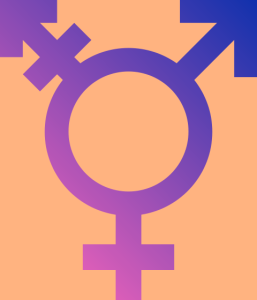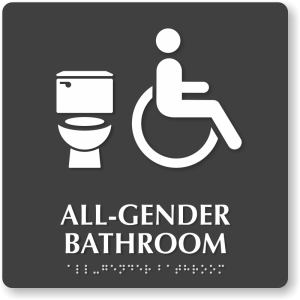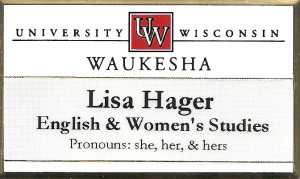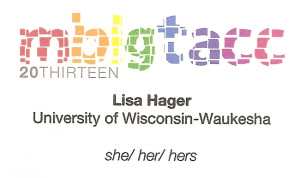Please note that this piece was originally published on Inside Higher Ed on April 27, 2015.
 In the past few years, transgender people and the discrimination they face have become much more visible through the work of folks like Laverne Cox, Mara Keisling, Janet Mock, Michael Munson and a whole host of everyday people standing up for the rights of trans people to be who they are. Consequently, trans inclusivity has become much more regularly a part of conversations on issues of diversity in academe. However, while we are often supportive of trans people generally, many academic institutions and events need to take concrete steps to put these sentiments into action.
In the past few years, transgender people and the discrimination they face have become much more visible through the work of folks like Laverne Cox, Mara Keisling, Janet Mock, Michael Munson and a whole host of everyday people standing up for the rights of trans people to be who they are. Consequently, trans inclusivity has become much more regularly a part of conversations on issues of diversity in academe. However, while we are often supportive of trans people generally, many academic institutions and events need to take concrete steps to put these sentiments into action.
To that end, I offer the recommendations below to encourage people to begin this process. These recommendations are not meant to be, by any means, a trans inclusivity cure-all. Instead, they are solid first steps for starting the process of creating trans-inclusive campuses and events.
Trans Inclusivity in the Academic Workplace
According to the National Center for Transgender Equality, “one in four transgender people have lost a job due to bias, and more than three-fourths have experienced some form of workplace discrimination.” Moreover, transgender people are also likely to quit or switch jobs to avoid facing anticipated discrimination and harassment, all of which means that we are losing valued employees and colleagues because our institutions have not worked to make public and visible their support of transgender workers.
As employers, then, academic institutions need to be leaders in creating and implementing trans-inclusive policies, as well as celebrating diversity of all kinds in the workplace. If we want our institutions to have the best people doing their best work, it is essential that we make comprehensive changes to protect and support our colleagues of diverse gender identities.
 An excellent place to start assessing your institution’s trans inclusivity is the Transgender Law Center’s Model Employer Policy, which covers everything from supporting an employee’s gender transition at work to providing all-gender restrooms in all buildings (signage for all-gender bathrooms is available for free for nonprofits from MyDoorSign). Also, many of the best practices in the Consortium of Higher Education LGBTQ Resource Professionals’ Suggested Best Practices for Supporting Trans* Students will also benefit faculty and staff members.
An excellent place to start assessing your institution’s trans inclusivity is the Transgender Law Center’s Model Employer Policy, which covers everything from supporting an employee’s gender transition at work to providing all-gender restrooms in all buildings (signage for all-gender bathrooms is available for free for nonprofits from MyDoorSign). Also, many of the best practices in the Consortium of Higher Education LGBTQ Resource Professionals’ Suggested Best Practices for Supporting Trans* Students will also benefit faculty and staff members.
In addition to these critical institutionwide changes, I recommend that that everyone include their gender pronouns anywhere their name and contact information appear, including email signatures, course syllabi, curriculum vitae, name tags and web pages. By spelling out which pronouns we use, we signal that we are aware that it’s impossible to know what pronouns a person uses by looking at them or their name. In addition, having pronouns be so visible encourages one-on-one conversations about pronouns and diverse genders.
 For instructors, I suggest asking students at the beginning of the term to indicate their gender pronouns (along with their names in use) on index cards that they hand into you (this avoids forcing students to out themselves in class). For further information on making classes welcoming for students, this handout from the University of Wisconsin-Madison is a great place to start.
For instructors, I suggest asking students at the beginning of the term to indicate their gender pronouns (along with their names in use) on index cards that they hand into you (this avoids forcing students to out themselves in class). For further information on making classes welcoming for students, this handout from the University of Wisconsin-Madison is a great place to start.
Four Steps to Make Academic Conferences More Welcoming to Transgender People
As a former conference organizer myself, I know how difficult and time-consuming conference organizing can be, so I would like to offer the following suggestions to creating a welcoming environment at any event for people of diverse gender identities.
1. Seek out papers, plenaries and other presentations on topics relating to diverse gender identities.
People are doing this work, and your event will be all the richer for incorporating it into the program. In addition, by publicly calling for trans-related content, your event will play a part in encouraging such work by demonstrating that it has a well-respected audience.
Depending on the topic of your conference or meeting, this can be as simple as including a bullet point in the call for papers or potential agenda items that relate the theme or topic to transgender and nonbinary gender identities. Another productive way of integrating discussion of trans issues into your event is adding sessions assessing the field’s openness to transgender and nonbinary professionals and addressing the ways in which the field can better support them — these sessions can be particularly useful if the event’s main topic doesn’t lend itself to a topic-related sort of connection. In these state-of-the-field sessions, it essential to have transgender and nonbinary people as the featured speakers.
2. Include a statement welcoming participants of diverse backgrounds, including those of diverse gender identities, on the conference program and website. The statement should also include information about all of the other steps and give a contact person for any harassment or discrimination issues.
These sorts of statements indicate the general culture of an event and can go a long way to creating a welcoming environment. Since transgender and nonbinary folks regularly experience discrimination and violence in their daily lives simply for being who they are, it is critical that organizations explicitly state both that such behavior will not be tolerated and that people of diverse gender identities are valued members of that particular academic community. For suggestions on crafting and implementing Codes of Conduct at conferences, see Dorothy Kim’s Medieval Studies, Sexual Harassment and Community Accountability.
3. Add pronouns to all conference name badges and ask that they be part of all presenters’ introductions. Always use the names that people have on their name tags.
 In the English language, we use gender pronouns a lot, so it is essential that we know the correct pronouns to use when referring to a person. Assuming that we can tell what pronouns a person uses by looking at them depends on a host of gender-expression cues, which we may or may not read correctly. If we misgender someone by using the wrong pronouns, we harm that person by not respecting their identity and put the onus on that person to correct us, which is likely embarrassing for everyone involved and may require any trans folks involved to out themselves. Moreover, increasing numbers of people are identifying as nonbinary genders (like agender and genderqueer) and using pronouns like “they,” “zie” and “per.”
In the English language, we use gender pronouns a lot, so it is essential that we know the correct pronouns to use when referring to a person. Assuming that we can tell what pronouns a person uses by looking at them depends on a host of gender-expression cues, which we may or may not read correctly. If we misgender someone by using the wrong pronouns, we harm that person by not respecting their identity and put the onus on that person to correct us, which is likely embarrassing for everyone involved and may require any trans folks involved to out themselves. Moreover, increasing numbers of people are identifying as nonbinary genders (like agender and genderqueer) and using pronouns like “they,” “zie” and “per.”
In terms of names, it’s important to use the names that attendees have on their name tags, since a person’s name may have changed since you last met. This is particularly important when introducing a person to someone else for many of the same reasons as misgendering someone with incorrect pronouns. By using an incorrect pronoun and/or name, you can not only cause an awkward social situation but can significantly increase a person’s experience of gender dysphoria — mental distress caused by the mismatch between a person’s gender and gender other people assign to that person.
By having pronouns on name badges, much of this misgendering and general awkwardness can be easily avoided. Here are three ways to go about doing this:
- Ask for pronouns as part of the conference registration form and print them below attendees’ names on the badges.
- Supply stickers for attendees to affix to their badges at registration.
- Have a prompt and space on the name badges for attendees to write in their pronouns.
- Use adhesive name badges that come with gender pronoun options.
Whenever asking for pronouns, be sure to supply many options and have a write-in option since people are crafting their own pronouns all the time.
Similarly, for conference sessions, encourage all moderators to ask presenters for permission to include pronouns in introductions. For example, “Next, we have Lisa Hager, who is at the University of Wisconsin-Waukesha, and uses ‘she,’ ‘her,’ ‘hers’ and ‘they,’ ‘them,’ ‘theirs.'”
Tip for presenters who use visuals: put your pronouns and Twitter handle at the bottom of every slide so that audience members can use this information during your presentation.
4. Designate at least one centrally located, wheelchair-accessible bathroom to be an all-gender bathroom and make sure that there is clear signage indicating the location of the bathroom for the duration of the event.
As the recent public conversations about transgender people using the bathrooms that correspond to their genders and the #WeJustNeedtoPee hashtag demonstrate, finding a safe bathroom can often be very difficult for transgender people. Academic conferences should make clear that they support the right of transgender people to use the bathroom of their choice.
However, since state and city laws regarding this right differ widely, designating an all-gender bathroom for the duration of the event is a great way to provide all transgender and gender-nonconforming attendees with safe facilities. In addition, gender-inclusive restrooms are critical for people who identify as nonbinary genders because such spaces do not require users to identify as either women or men. I would also like to add that as a cisgender person, using all-gender bathrooms has made me rethink a lot of the ways I understand bathrooms as gendered spaces and has helped me be a better supporter of transgender people.
Because this is such a basic need, conference organizers should ask potential venues if they have all-gender bathrooms available, and this information should play an important role in deciding on a venue. By asking this question, organizers are also signaling to venues that all-gender bathrooms are selling point in attracting business to the venue.
Transgender 101 Resources
- 10 Misconceptions Every Trans Ally Needs to Understand
- Everything You Always Wanted to Know About Transgender People but Were Afraid to Ask
- Pronoun Guides
- I Think I Might Be Trans: 8 Important Notes on Questioning and 50+ Resources to Get You Started
- GLAAD’s Terminology Guide
- Refuge Restrooms (mobile app for finding gender-inclusive restrooms)
- Trans-focused presses
